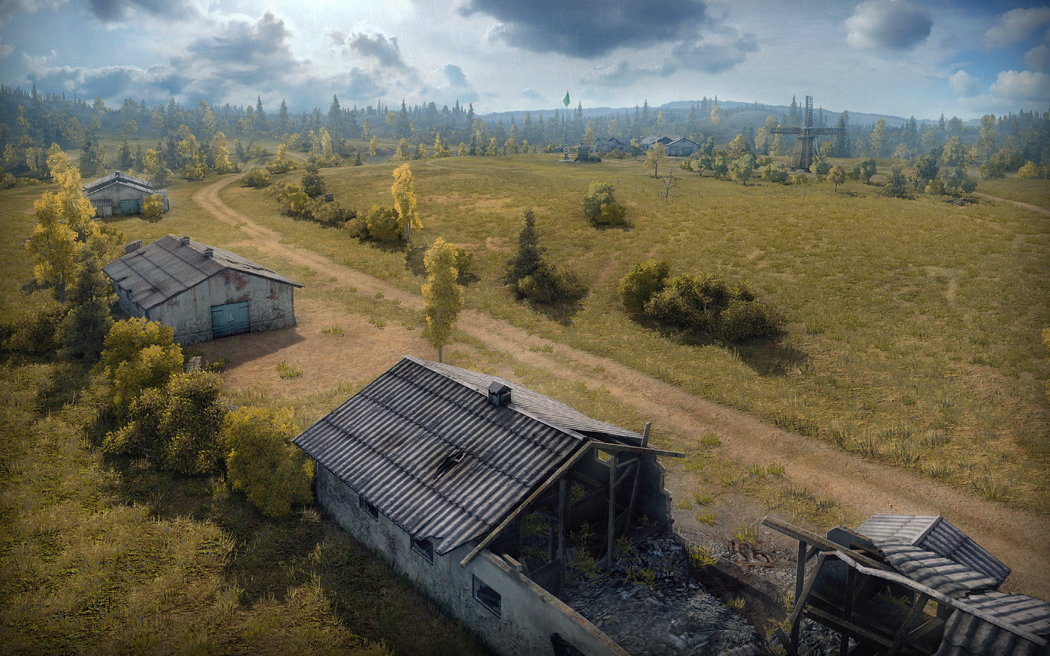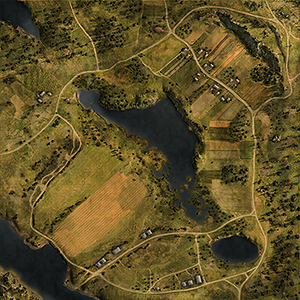Difference between revisions of "Malinovka"
| Revision as of 15:02, 6 August 2013 | Revision as of 21:51, 17 February 2017 | |||
5 intermediate revisions by 5 users not shown | ||||
| Line 1: | Line 1: | |||
| ? | {{ | + | {{MapDetails | |
| + | |Size = 1000×1000 | |||
| + | |Map type = Summer | |||
| + | |Battle Tier limit = 1-11 | |||
| + | }} | |||
| ? | + | Initial staging areas are separated by a wide open field, ideal for [[Self-Propelled Guns|artillery]] and defensive operations. Make use of flanking maneuvers and natural defenses like woods, hills, and farmhouses, as these can be decisive. Another option is a well-coordinated high-speed combined arms attack across the field which could bring victory, but at the risk of a bloody loss. Colloquially also known as "Campinovka" for the tendency of most players to just sit behind cover on their side of the starting field and snipe each other. | ||
| ? | There are plenty of different theories on how to win this map. | + | There are plenty of different theories on how to win this map. An excellent tactic is to simply hold out, with the majority of the armor on the main line with a few light, medium, heavy tanks as well as a TD to hold the east side. Tell teammates to hold out and refrain from charging. When the enemy is depleted, that is their armor is reduced to a few tanks, charge. The trick to doing well here is team work, regardless of the tactics used. While communication is often difficult in Random Battles, having just a few people talking to each other can turn the tide. [[Self-Propelled Guns|Artillery]] has little to stand in its way if appropriately placed, less the depression on the west spawn and the buildings in the east spawn. | |
| + | {{VideoYT|ps0fic0lPrc}} | |||
| ? | + | = Standard Battle = | ||
| The map is very wide open, and thus sniping is key. There are two main locations of engagement: | The map is very wide open, and thus sniping is key. There are two main locations of engagement: | |||
| ? | ||||
| ? | ||||
| ? | At the start of the battle, the first thing to do is to | + | Across no-man's land, between both spawns. This favors sniping. | |
| + | The hill and the area below it. This favors flanking and brawling. | |||
| + | At the start of the battle, the first thing to do is to check the number of scouts and [[Self-Propelled Guns|SPGs]] - how many scouts do you have and how many scouts do they have, and are there [[Self-Propelled Guns|SPGs]] to support them? This will decide how the initial strategy plays out. | |||
| ? | + | If you have more scouts than the opponent, send a skilled scout to light up the side of the enemy field, as the distance between the spawns is smaller than the drawing limit. Tank Destroyers and tanks with sniping capability should be prepared to shoot anything that is lit up, and SPGs should be aiming at the enemy standoff line, marked by the line of rocks on one side and the line of houses on the other. [[Self-Propelled Guns|SPGs]] should also report any environmental changes, such as trees falling, to the team. Hopefully, this should result in substantial portions of the enemy team being lit up and damaged. Alternatively, [[Light Tanks|lights]] can try flanking the enemy position via the hill side, but this may be difficult considering that they will encounter enemy forces heading for the hill. This should only be attempted by skilled drivers with high Camouflage skill. Successful breakthrough, however, will often light up the enemy SPGs, leading to their neutralization or at least forcing them out of position for some time. | ||
| ? | Alternatively, lights can try flanking the enemy position via the hill side, but this may be difficult considering that they will encounter enemy forces heading for the hill. This should only be attempted by skilled drivers with high Camouflage skill. Successful breakthrough, however, will often light up the enemy SPGs, leading to their | + | ||
| It goes without saying that tanks less suited for sniping should head for the hill, as it is to their advantage. | It goes without saying that tanks less suited for sniping should head for the hill, as it is to their advantage. | |||
| ? | + | If your opponents have more scouts, leave a token force to defend, with good shooters who can hit scouts. Otherwise, many tanks can be lost to enemy spotting as the field is still much wider than the average tank's spotting range. Send the full force to the hill for better odds of overwhelming the enemy position. | ||
| ? | + | |||
| ? | + | |||
| ? | + | If there is a lack of scouts, the [[M18 Hellcat]] will often suffice when placed in the bushes at the southwest side of the field. Alternatively, a tougher heavy tank can be placed there, which will draw bounced shots and expose enemies to fire. This works best when there are no enemy SPGs in play. | ||
| ? | Below the hill is a wide open area. This is very exposed to both team's forests (and sometimes even their base), so only fast tanks or tanks with very tough fronts should use this area. Mediums can conduct nasty flanking operations here and lights can slip past to the SPGs to eliminate them. This is where heavier tank destroyers like the [[T28]] and [[AT 15]] have a niche as defenders without needing to struggle up the hill and expose their sides. | + | Mid-battle, the focus shifts to the Hill, where [[Heavy Tanks|heavy tanks]] will often brawl with each other at mid-range. This region is often the deciding factor between victory and defeat, and standard brawling tactics apply. Do note, however, that South spawn has access to a windmill as cover, so the other team will need to push hard to force them out. Bouncier [[Medium Tanks|mediums]] like the [[T-44]] come in handy here, and American heavies should find the terrain ideal for hull-down tactics. The region is exposed to [[Self-Propelled Guns|SPG]] fire, so staying artillery safe is of importance (especially with 8.6 and top tier SPGs). | |
| + | ||||
| + | Below the hill is a wide open area. This is very exposed to both team's forests (and sometimes even their base), so only fast tanks or tanks with very tough fronts should use this area. [[Medium Tanks|Mediums]] can conduct nasty flanking operations here and [[Light Tanks|lights]] can slip past to the [[Self-Propelled Guns|SPGs]] to eliminate them. This is where heavier [[Tank Destroyers|tank destroyers]] like the [[T28]] and [[AT 15]] have a niche as defenders without needing to struggle up the hill and expose their sides. | |||
| By end-game, the match should be decided. Field defenders from the winning team should push forward to get themselves some kills. If it goes down to the wire, good brawlers such as the [[IS-3]] will have good chances winning duels with survivors. | By end-game, the match should be decided. Field defenders from the winning team should push forward to get themselves some kills. If it goes down to the wire, good brawlers such as the [[IS-3]] will have good chances winning duels with survivors. | |||
| Line 31: | Line 35: | |||
| All in all, hold the field, take the hill and sweep down for the win. | All in all, hold the field, take the hill and sweep down for the win. | |||
| ? | + | = Encounter Battle = | ||
| The capture circle is at the eastern side of the field, and is VERY exposed. As such, the priority is not the cap - it is again, the hill. | The capture circle is at the eastern side of the field, and is VERY exposed. As such, the priority is not the cap - it is again, the hill. | |||
| ? | At the beginning of the match, ALL heavy tanks should immediately proceed to the hill for a violent confrontation. Due to the high visibility of each spawn from the other side, scouts can be sent across the foot of the hill to light up the enemy position. Their chances of survival are pretty slim, so tank destroyers should be ready to act on this targeting information, and fast. | + | At the beginning of the match, ALL [[Heavy Tanks|heavy tanks]] should immediately proceed to the hill for a violent confrontation. Due to the high visibility of each spawn from the other side, scouts can be sent across the foot of the hill to light up the enemy position. Their chances of survival are pretty slim, so [[Tank Destroyers|tank destroyers]] should be ready to act on this targeting information, and fast. | |
| ? | However, one important thing not to neglect is to send a bunch of mediums, lights and tank destroyers to the field, where they can keep the cap secure. If there are sufficient heavies, an agile brawler like the [[IS]] will be a good tank to send to the cap area. From there, they can either hold position, or make a brazen flanking move across the far edge of the field. If either team successfully gets a flank, the SPGs will be in great danger, so ensure sufficient defense at the cap. | + | However, one important thing not to neglect is to send a bunch of [[Medium Tanks|mediums]], [[Light Tanks|lights]] and [[Tank Destroyers|tank destroyers]] to the field, where they can keep the cap secure. If there are sufficient heavies, an agile brawler like the [[IS]] will be a good tank to send to the cap area. From there, they can either hold position, or make a brazen flanking move across the far edge of the field. If either team successfully gets a flank, the [[Self-Propelled Guns|SPGs]] will be in great danger, so ensure sufficient defense at the cap. | |
| Again, the winning team will be able to swoop down from the hill and finish off opposition. The field team should then push, as usual, to wipe out the remaining enemy tanks. | Again, the winning team will be able to swoop down from the hill and finish off opposition. The field team should then push, as usual, to wipe out the remaining enemy tanks. | |||
| Line 44: | Line 48: | |||
| All in all, once again, the hill is key. The cap cannot be taken without securing the hill, which must be the first and foremost objective of any team seeking to claim another victory. | All in all, once again, the hill is key. The cap cannot be taken without securing the hill, which must be the first and foremost objective of any team seeking to claim another victory. | |||
| + | ||||
| + | = Tactics = | |||
| + | ||||
| + | Both the encounter and standard battle modes are played on this map. | |||
| + | ||||
| + | In standard battles, the spawns for the two teams are at D2 and J6, with arties starting in the forests at B4 and G9. There are generally three ways to go at the enemy: Cross the field, skirt the field edge, or go to the hill in the northeast. Those that cross the field arefield. The north road is wider than the south, allowing for more maneuverability, and has rocks scattered about to give protection. However, tanks advancing on this road may be flanked by both tanks at the enemy base and tanks on the hill. The south road is narrower with little protection, but unlike the north road, the enemy is only coming from one direction. This road is usually used near the end of the game by tanks who have been at base, and can safely cross into enemy territory. The last of the roads, the hill, is the main route for striking the enemy base. The two parts here are the hill and the flat area of land below it. The latter has a town that can be used as temporary cover, and those who use it have a chance of flanking enemies on the hill, or getting a direct path to the enemy base, but usually come under fire from both of those groups (that is, both tanks at base and on the hill). The hill itself is mostly a slugging party with a lone building to give shelter. Winning the hill can be a valuable way to reach the opponent, but there will almost always be enemies coming for it to achieve the same goal. Malinovka's bases both appear to have great protection at first, with solid walls that have windows for shooting through facing a plain that can be difficult to cross, and almost always, tanks will begin camping behind those walls. This led to the name "Campinovka", where tanks would just sit behind those walls, waiting for enemies to come by. Usually, after the first two minutes, all enemies that dare to cross the field have been either driven away or (more likely) burnt to a crisp, so it is better to leave the base less defended after the initial field-crossing wave. | |||
| + | ||||
| + | In encounter battles, the spawns for the teams are at the base of the hill, at A6 and D0. The flag is at F5, smack at the middle of the map. Capping is rarely a success here because you can be fired on while capping from almost anywhere on the map. Here, the hill becomes the battlefield, and most tanks will climb up the hill, while other tanks snipe at advancing opponents. A few of the faster tanks may try to circle around the map by going through the south road of the field, and try to get at the weaker tanks behind lines, or just to light up the enemy. | |||
| + | ||||
| + | {{To Do}} | |||
| [[category:maps]] | [[category:maps]] | |||
Revision as of 21:51, 17 February 2017
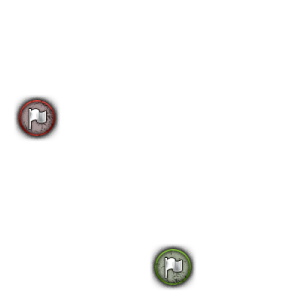
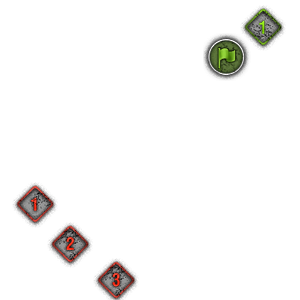
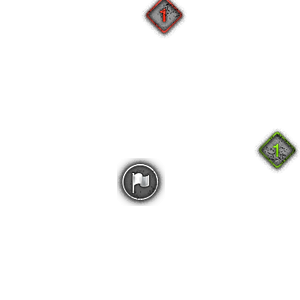
- Map
- Standard battle
- Assault
- Encounter Battle
Initial staging areas are separated by a wide open field, ideal for artillery and defensive operations. Make use of flanking maneuvers and natural defenses like woods, hills, and farmhouses, as these can be decisive. Another option is a well-coordinated high-speed combined arms attack across the field which could bring victory, but at the risk of a bloody loss. Colloquially also known as "Campinovka" for the tendency of most players to just sit behind cover on their side of the starting field and snipe each other.
There are plenty of different theories on how to win this map. An excellent tactic is to simply hold out, with the majority of the armor on the main line with a few light, medium, heavy tanks as well as a TD to hold the east side. Tell teammates to hold out and refrain from charging. When the enemy is depleted, that is their armor is reduced to a few tanks, charge. The trick to doing well here is team work, regardless of the tactics used. While communication is often difficult in Random Battles, having just a few people talking to each other can turn the tide. Artillery has little to stand in its way if appropriately placed, less the depression on the west spawn and the buildings in the east spawn.
Standard Battle
The map is very wide open, and thus sniping is key. There are two main locations of engagement:
Across no-man's land, between both spawns. This favors sniping. The hill and the area below it. This favors flanking and brawling. At the start of the battle, the first thing to do is to check the number of scouts and SPGs - how many scouts do you have and how many scouts do they have, and are there SPGs to support them? This will decide how the initial strategy plays out.
If you have more scouts than the opponent, send a skilled scout to light up the side of the enemy field, as the distance between the spawns is smaller than the drawing limit. Tank Destroyers and tanks with sniping capability should be prepared to shoot anything that is lit up, and SPGs should be aiming at the enemy standoff line, marked by the line of rocks on one side and the line of houses on the other. SPGs should also report any environmental changes, such as trees falling, to the team. Hopefully, this should result in substantial portions of the enemy team being lit up and damaged. Alternatively, lights can try flanking the enemy position via the hill side, but this may be difficult considering that they will encounter enemy forces heading for the hill. This should only be attempted by skilled drivers with high Camouflage skill. Successful breakthrough, however, will often light up the enemy SPGs, leading to their neutralization or at least forcing them out of position for some time.
It goes without saying that tanks less suited for sniping should head for the hill, as it is to their advantage.
If your opponents have more scouts, leave a token force to defend, with good shooters who can hit scouts. Otherwise, many tanks can be lost to enemy spotting as the field is still much wider than the average tank's spotting range. Send the full force to the hill for better odds of overwhelming the enemy position.
If there is a lack of scouts, the M18 Hellcat will often suffice when placed in the bushes at the southwest side of the field. Alternatively, a tougher heavy tank can be placed there, which will draw bounced shots and expose enemies to fire. This works best when there are no enemy SPGs in play.
Mid-battle, the focus shifts to the Hill, where heavy tanks will often brawl with each other at mid-range. This region is often the deciding factor between victory and defeat, and standard brawling tactics apply. Do note, however, that South spawn has access to a windmill as cover, so the other team will need to push hard to force them out. Bouncier mediums like the T-44 come in handy here, and American heavies should find the terrain ideal for hull-down tactics. The region is exposed to SPG fire, so staying artillery safe is of importance (especially with 8.6 and top tier SPGs).
Below the hill is a wide open area. This is very exposed to both team's forests (and sometimes even their base), so only fast tanks or tanks with very tough fronts should use this area. Mediums can conduct nasty flanking operations here and lights can slip past to the SPGs to eliminate them. This is where heavier tank destroyers like the T28 and AT 15 have a niche as defenders without needing to struggle up the hill and expose their sides.
By end-game, the match should be decided. Field defenders from the winning team should push forward to get themselves some kills. If it goes down to the wire, good brawlers such as the IS-3 will have good chances winning duels with survivors.
All in all, hold the field, take the hill and sweep down for the win.
Encounter Battle
The capture circle is at the eastern side of the field, and is VERY exposed. As such, the priority is not the cap - it is again, the hill.
At the beginning of the match, ALL heavy tanks should immediately proceed to the hill for a violent confrontation. Due to the high visibility of each spawn from the other side, scouts can be sent across the foot of the hill to light up the enemy position. Their chances of survival are pretty slim, so tank destroyers should be ready to act on this targeting information, and fast.
However, one important thing not to neglect is to send a bunch of mediums, lights and tank destroyers to the field, where they can keep the cap secure. If there are sufficient heavies, an agile brawler like the IS will be a good tank to send to the cap area. From there, they can either hold position, or make a brazen flanking move across the far edge of the field. If either team successfully gets a flank, the SPGs will be in great danger, so ensure sufficient defense at the cap.
Again, the winning team will be able to swoop down from the hill and finish off opposition. The field team should then push, as usual, to wipe out the remaining enemy tanks.
Often, the Encounter battle goes to the wire. In this case, tanks should stick together and/or send out a scout. The slope of the capture zone can cover one's tank from the other side of the field at the cost of being exposed from the hill, so use that for hull-down positioning.
All in all, once again, the hill is key. The cap cannot be taken without securing the hill, which must be the first and foremost objective of any team seeking to claim another victory.
Tactics
Both the encounter and standard battle modes are played on this map.
In standard battles, the spawns for the two teams are at D2 and J6, with arties starting in the forests at B4 and G9. There are generally three ways to go at the enemy: Cross the field, skirt the field edge, or go to the hill in the northeast. Those that cross the field arefield. The north road is wider than the south, allowing for more maneuverability, and has rocks scattered about to give protection. However, tanks advancing on this road may be flanked by both tanks at the enemy base and tanks on the hill. The south road is narrower with little protection, but unlike the north road, the enemy is only coming from one direction. This road is usually used near the end of the game by tanks who have been at base, and can safely cross into enemy territory. The last of the roads, the hill, is the main route for striking the enemy base. The two parts here are the hill and the flat area of land below it. The latter has a town that can be used as temporary cover, and those who use it have a chance of flanking enemies on the hill, or getting a direct path to the enemy base, but usually come under fire from both of those groups (that is, both tanks at base and on the hill). The hill itself is mostly a slugging party with a lone building to give shelter. Winning the hill can be a valuable way to reach the opponent, but there will almost always be enemies coming for it to achieve the same goal. Malinovka's bases both appear to have great protection at first, with solid walls that have windows for shooting through facing a plain that can be difficult to cross, and almost always, tanks will begin camping behind those walls. This led to the name "Campinovka", where tanks would just sit behind those walls, waiting for enemies to come by. Usually, after the first two minutes, all enemies that dare to cross the field have been either driven away or (more likely) burnt to a crisp, so it is better to leave the base less defended after the initial field-crossing wave.
In encounter battles, the spawns for the teams are at the base of the hill, at A6 and D0. The flag is at F5, smack at the middle of the map. Capping is rarely a success here because you can be fired on while capping from almost anywhere on the map. Here, the hill becomes the battlefield, and most tanks will climb up the hill, while other tanks snipe at advancing opponents. A few of the faster tanks may try to circle around the map by going through the south road of the field, and try to get at the weaker tanks behind lines, or just to light up the enemy.
| |
This article is a stub. You can help the Wargaming wiki by expanding it. |
